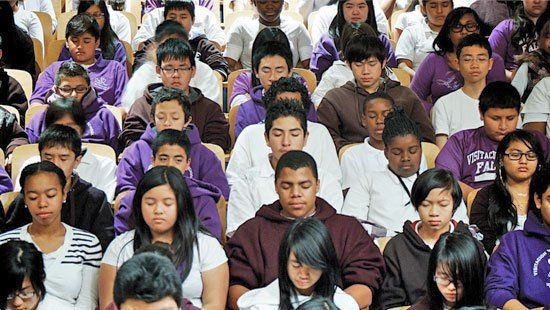
School of Silence
- July 2011
Laurent Valosek, formerly of Fairfield, IA, the director of the Quiet Time initiative in the San Francisco school district, was back in town recently to present the program’s latest developments. Many people are familiar with this program and others like it, teaching Transcendental Meditation to mostly disadvantaged students in some of the most troubled urban schools, with the aid of the David Lynch Foundation and other benefactors. But there is much more to hear; if you have the chance to attend a presentation on this program in the future, it will be well worth your time. I count this initiative to be among the most inspiring and encouraging developments in the TM organization — not only because of the benefits it is delivering to students and schools, but also as an example of how to bring the fruits of meditation into the public sphere, where it needs to be if it is to have the widest benefit.
There are many remarkable things about this story. Fresh, unrehearsed video clips from students, teachers, and administrators attest to the immediate and dramatic effects this structured "quiet time" is having in their lives. New research points to stunning improvements. But equally impressive is how skillfully and pragmatically Laurent and his team worked to make TM, for all its initial sense of foreignness, come to be seen as an indispensible tool for development in the educational system. This is no small thing, and in fact it is the Great Big Thing that needs to be replicated, in ever-widening circles, for TM to fulfill its long-desired mission.
The Quiet Time team consciously developed skills for speaking to different groups of people — administrators, teachers, students — appropriately for each context, so that the core essence of what TM offers could be seen clearly, with the least esoteric associations, and received with the least resistance. Moreover, realizing that a school district is a highly political system, the team made sure that it built the broadest level of support and acceptance, by patiently and methodically bringing TM to administrators at the district headquarters and in the schools. This was invaluable when challenges arose, especially from those who worried that TM is religious. While the normal response of the school district would have been to close the program down rather than face a legal dispute, enough strong support for TM had already been established among important staffers that the legal counsel agreed to work with Laurent’s team to prepare dozens of documents answering the concerns on strong legal grounds. So far, so good.
Today, the superintendent of schools is an extremely strong supporter — going so far as to call it a "civil rights issue" to make meditation available in all the schools. The Quiet Time program has plans to expand into more San Francisco schools and into Oakland, and hopes to collaborate with prominent researchers to document the effects. There is a need for more financial support and also for TM teachers, especially those with educational experience and a good ability to connect with urban middle and high school students. The decades-old dream of meditation as an essential skill taught universally is alive in the Bay area; may this momentum, and this fresh, clean approach to teaching, continue to grow.
